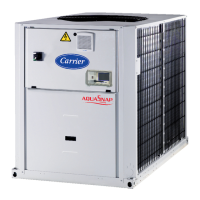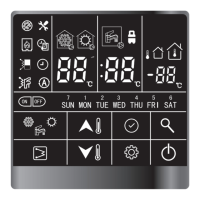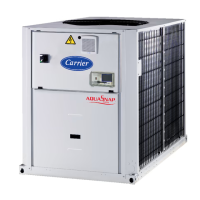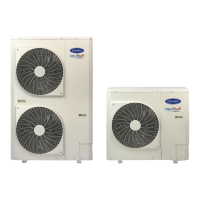9 - NOMINAL SYSTEM WATER FLOW CONTROL
9.1 - General
The optional water circulation pumps of the 61AF units have been
sized to allow the hydraulic modules to cover all possible
congurations based on the specic installation conditions, i.e. for
various temperature dierences between the entering and the
leaving water (ΔT) at full load, which can vary between 3 and 10
K. This required dierence between the entering and leaving water
temperature determines the nominal system ow rate.
The pump of the hydraulic module is a variable speed pump. Two
dierent water ow control can be selected:
- xed speed control
- variable speed control based on constant temperature
dierence.
Default factory setting is xed speed. Settings change need to be
done by a Carrier Service representant.
For both ow control and for energy saving, the speed of the pump
will be reduced to its minimum when unit capacity is 0%.
It is essential to know the nominal system ow rate to be able to
control it, using the variable pump speed or a manual valve that
must be on the water leaving piping of the system (item 20 in the
typical hydraulic circuit diagram).
The ow control with the pump speed or with the valve permits
adjustment of the pressure/system ow rate curve in accordance
with the pump pressure/ow rate curve to obtain the nominal ow
rate at the required operating point (see example for unit size
61AF 035). The pressure drop reading in the plate heat exchanger
is used as means of control and adjustment of the nominal system
ow rate. This reading can be taken with a dierential pressure
gauge that must be installed at the heat exchanger inlet and outlet.
Use the specications of the unit selection to know the system
operating conditions and to deduce the nominal ow rate and the
plate heat exchanger pressure drop at the specied conditions. If
this information is not available at the system start-up, contact the
technical service department responsible for the installation to get
it.
These characteristics can be obtained with the Electronic
Catalogue selection program for all ΔT conditions in the range of
3 to 10 K.
For domestic hot water applications (leaving water temperatures
above 60°C) the control cannot be made at a ΔT below 8 K at the
condenser.
9.2 - Water ow control procedure (xed speed)
Hydraulic circuit cleaning procedure
- Open the valve fully (item 20) if present.
- Start-up the system or unit pump (by quick test), if the unit is
equipped with a hydraulic module with a pump.
- Read the plate heat exchanger pressure drop by taking the
dierence of the readings of the pressure gauge connected
to the unit inlet and outlet (item 19).
- Let the pump run for two consecutive hours to clean the
system hydraulic circuit (presence of solid contaminants).
- Take another reading.
- Compare this value to the initial value.
- If the pressure drop has decreased, this indicates that the
screen lter must be removed and cleaned, as the hydraulic
circuit contains solid particles. In this case close the shut-o
valves at the water inlet and outlet (item 17) and remove the
screen lter (item 18 or 1 for a unit with hydraulic module)
after emptying the hydraulic section of the unit (item 4).
- Purge the air from the circuit (items 10 and 15).
- Renew, if necessary, to ensure that the filter is not
contaminated.
Water ow control procedure
- When the circuit is cleaned, read the pressures at the
dierential pressure gauge (BPHE leaving water pressure
-BPHE entering water pressure), to nd out the pressure drop
for the plate heat exchanger and the internal piping.
- Compare the value obtained with the theoretical selection
value.
- If the pressure drop measured is higher than the value
specied this means that the unit ow rate (and thus system
ow rate) is too high. The pump supplies an excessive ow
rate based on the global pressure drop of the application. In
this case close the control valve or reduce the pump speed.
Read the new pressure dierence.
- Proceed by successively closing the control valve or reducing
the pump speed until you obtain the specic pressure drop
that corresponds to the nominal ow rate at the required unit
operating point.
- Verify the minimum speed pump setting(when unit capacity
is 0%) is compatible with the ow switch protection (no ow
switch alarm for minimum speed).
NOTE: If the system has an excessive pressure drop in
relation to the available static pressure provided by the
system pump the nominal water ow rate cannot be obtained
(the resulting flow rate is lower) and the temperature
dierence between the condenser entering and leaving water
will increase.
To reduce the pressure drops of the hydraulic system, it is
necessary:
- to reduce the individual pressure drops as much as possible
(bends, level changes, accessories, etc.).
- to use a correctly sized piping diameter.
- to avoid hydraulic system extensions, wherever possible.
Example: 61AF 035 at Eurovent conditions of 1.76 l/s
Pressure drop, kPa
Water ow rate, l/s
2
1
3
4
5
B
A
0
4
8
Legend
1 ‘BPHE pressure drop/ow rate’’ curve
2 With the valve open or with the maximum pump speed, the pressure drop read
(18 kPa) gives point A on the curve.
A Operating point reached with the valve open / maximum pump speed.
3 The ow rate achieved is 3.4 l/s: this is too high, and the valve must be closed
or the pump speed decreased.
4 With valve is partially closed or speed decreased, the pressure drop read (6
kPa) gives point B on the curve.
B Operating point reached with the valve partially closed / pump speed reduced.
5 The ow rate achieved is 1.76 l/s: this is the required ow rate and the settings
are adequate

